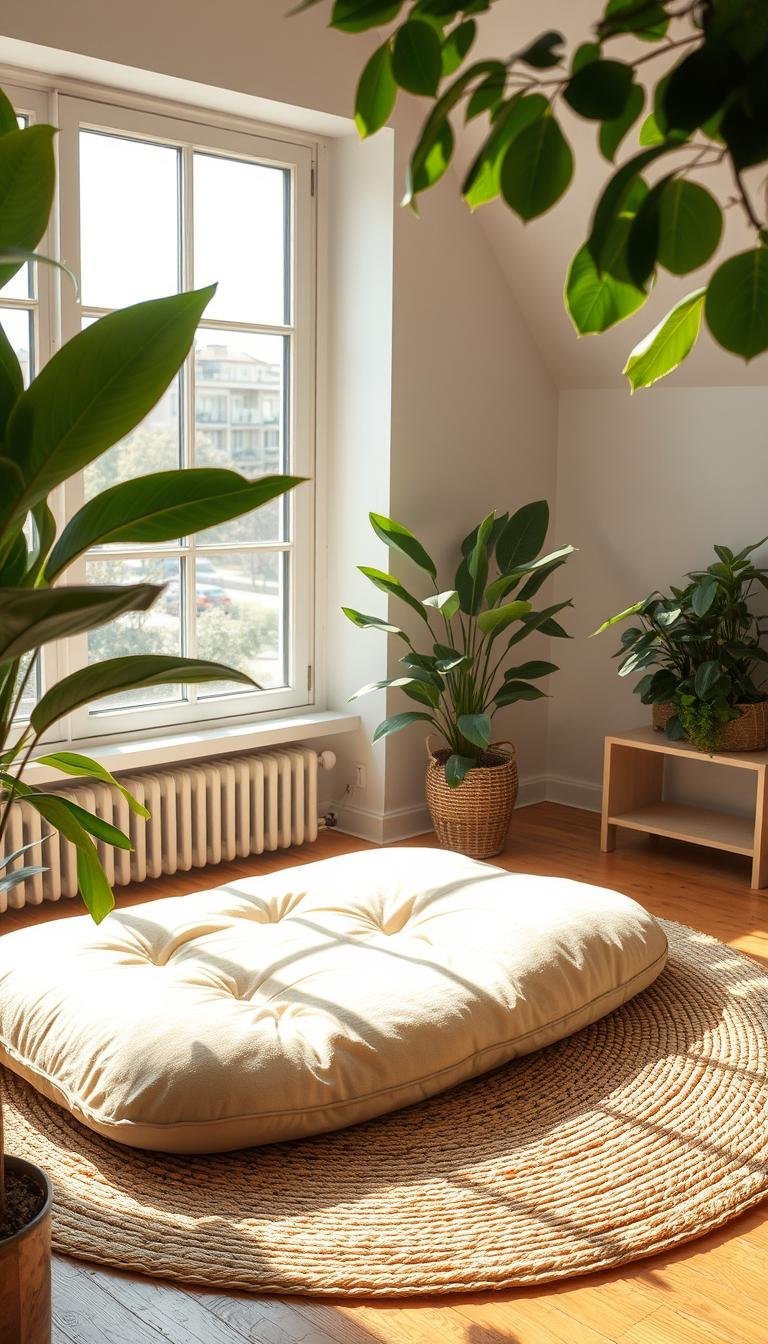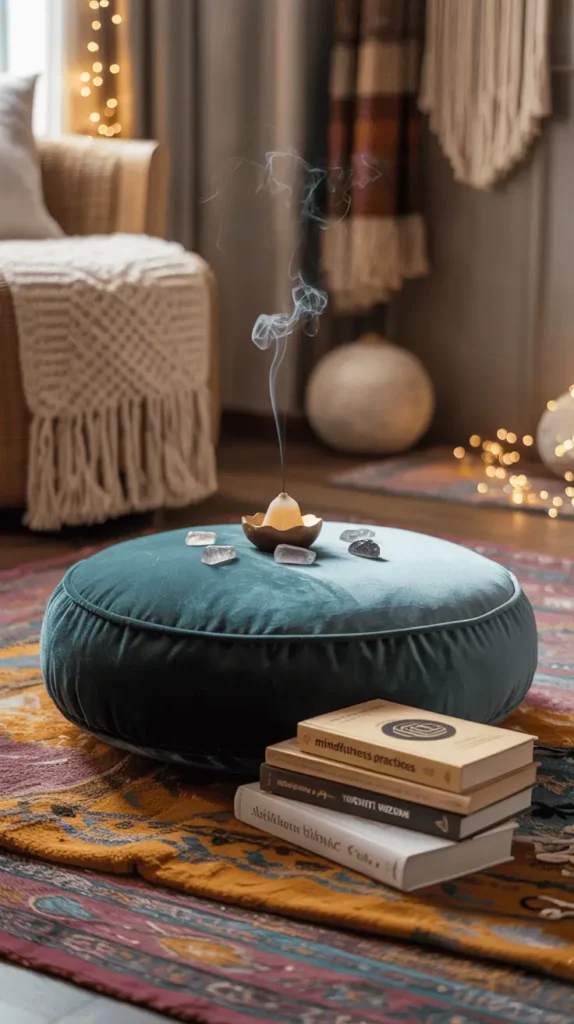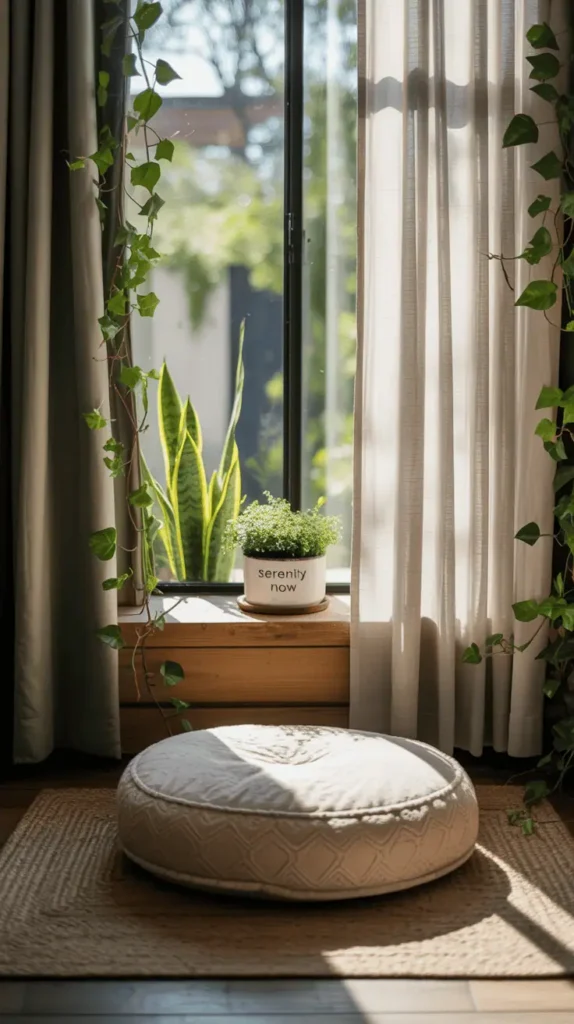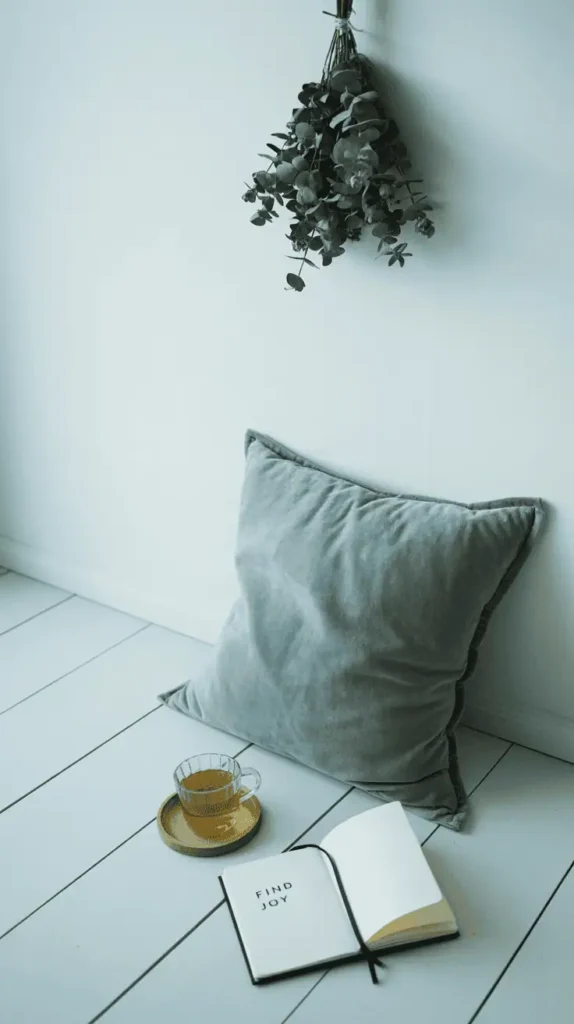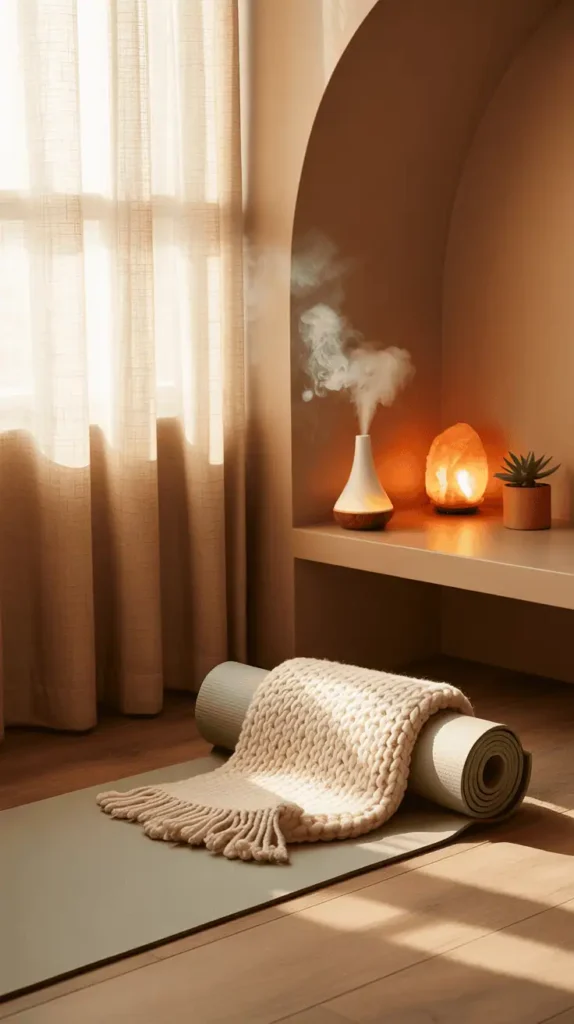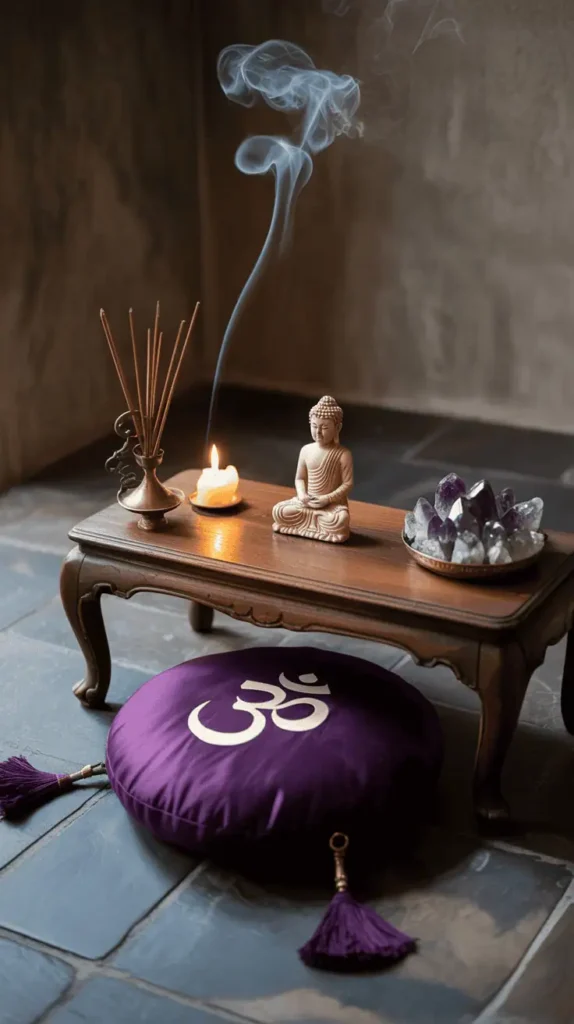(Hey! Some links in this post may be affiliate links — meaning I may earn a small commission if you buy through them, at no extra cost to you. As an Amazon Associate, I earn from qualifying purchases. I only share products I genuinely love and think you’ll find useful too. Read the full disclosure here).
A meditation corner turns any home into a calm sanctuary. Even in small spaces, you can find peace. A simple chair, mat, or cushion in a corner creates a personal retreat.
Creating a meditation corner isn’t about being perfect. It’s about making it a regular part of your day. Whether it’s a quiet spot by a window, a repurposed closet, or a desk nook, it works. Focus on making it your own, and you’ll find mindfulness without spending a lot of time or money. Start your peaceful space today.
Contents
- 1 What is a Meditation Corner?
- 2 Choosing the Perfect Space in Your Home
- 3 Essential Elements for a Meditation Corner
- 4 Decor Ideas for Your Meditation Space
- 5 The Role of Accessories in Meditation
- 6 Setting the Mood for Meditation
- 7 Establishing a Meditation Routine
- 8 Family-Friendly Meditation Corners
- 9 Maintaining Your Meditation Corner
- 10 Online Resources and Apps for Meditation
- 11 Celebrating Your Meditation Journey
What is a Meditation Corner?
A meditation corner is a special spot for calm and focus. It can be a room corner or a small nook. This area is your path to mindfulness. Let’s see how it works.
Definition and Purpose
A mindfulness area or tranquility nook is for meditation. It tells your brain to pause and think. This spot can be simple, like a chair with a blanket, or more elaborate, like a room with special lights.
The important thing is to be consistent. It becomes a signal to relax.
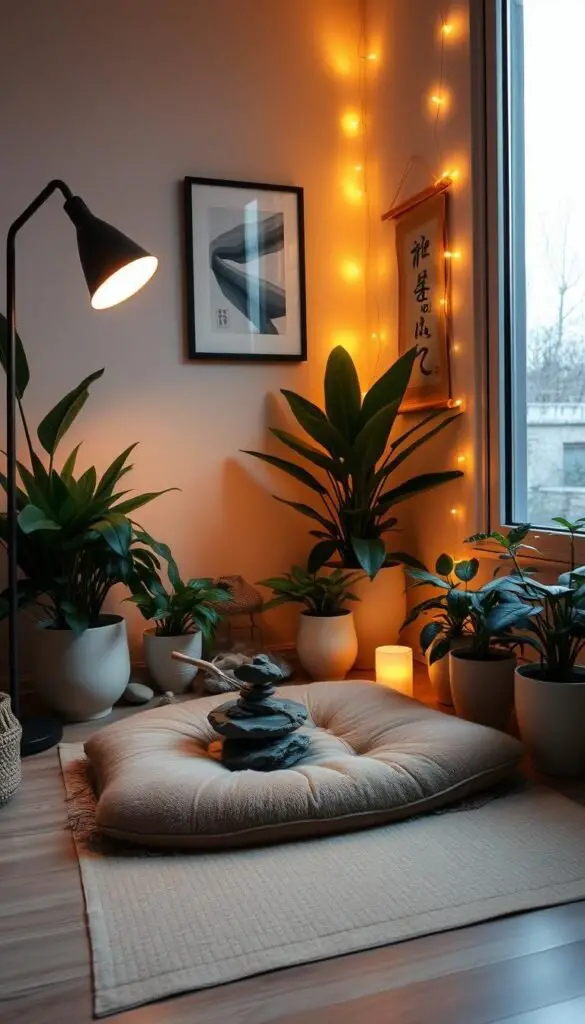
Benefits of Meditation Corners
- Improved mental clarity: A regular spot helps your mind get into meditation quicker.
- Reduced stress: A calm place lowers anxiety during meditation.
- Enhanced focus: Your brain learns to focus deeply in this space over time.
Even small areas can be great. A tranquility nook can be in a closet or under a window. The aim is to make it your own. This space is not just physical. It’s a mental tool for your well-being.
Choosing the Perfect Space in Your Home
Turn any corner into a zen space by focusing on what you need. Look for calm and inviting spots. Find areas with soft natural light and little noise, like quiet spots near windows or under staircases.
Location Matters
- Quiet zones: Choose spots away from TVs, doorways, or busy areas.
- Natural light: South-facing windows bring gentle morning light, making a relaxation spot feel cozy.
- Privacy options: Use dividers or curtains if you share the space with others.
Picking the Right Furniture
Comfort and simplicity are essential. Pick low-profile seating like floor cushions or a folding stool. Add a small side table for candles or crystals. Choose materials like bamboo or cotton for a peaceful feel.
Even small spaces can be great—turn a bookshelf corner or a closet into a meditation nook. Your zen space should fit your life, not the other way around.
Essential Elements for a Meditation Corner
Creating a meditation corner involves picking items that bring calm and focus. These elements transform any spot into a place for quiet thought, known as a contemplation corner or meditation corner. Each item should match your taste and the space you have.
Lighting Solutions
Lighting greatly affects the mood. Soft, changeable lights like candles or salt lamps help avoid eye strain. A window or skylight brings in natural light, grounding the area. As mindfulness teacher Thich Nhat Hanh noted:
“Soft light invites calm, helping the mind find peace.”
- Candles or fairy lights for a cozy feel
- Himalayan salt lamps for a warm, soft light
- Dimmable LED panels for easy brightness control
Comfortable Seating
Opt for seating that supports your back without discomfort. Meditation cushions or ergonomic benches help keep your spine straight. Here are some choices:
- Foldable benches for back support
- Yoga bolsters for sitting or lying
- Low stools or floor cushions
Incorporating Nature
Bring nature indoors. Plants like snake plants or lavender improve air quality and calm the senses. Stones, seashells, or small fountains connect you to nature. Think about:
- A small tabletop water fountain
- Herb pots like rosemary for scent
- Driftwood or river rocks as focal points
Begin with one or two items and add more as you like. Each new addition makes your meditation corner even more peaceful.
Decor Ideas for Your Meditation Space
Turn your meditation spot into a peaceful haven with careful decor choices. Each element in your serenity nook helps create a peaceful space for mindfulness. Follow these tips to craft a personal retreat.
Color Schemes that Promote Calmness
Colors greatly influence the mood of your meditation area. Soft blues, like the sky or ocean, bring calmness. Earthy greens and neutral shades, like beige or cream, also bring a sense of calm, mirroring nature.
Try out different colors with throw pillows or wall art. See which ones feel most right for you.
Art and Decor that Inspire Mindfulness
Choose images that help you stay focused. Consider:
- Nature photography of forests or water
- Geometric mandalas for visual grounding
- Abstract art with smooth lines and minimal clutter
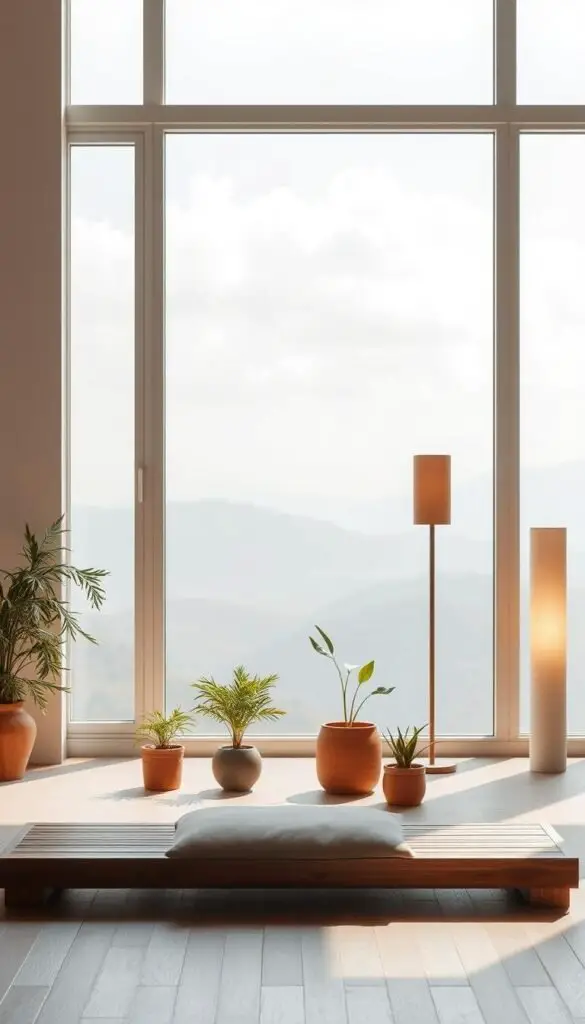
Personal Touches to Elevate Your Corner
Add personal touches to make your space truly yours. Display a meaningful quote, arrange seashells from a special trip, or place a statue that represents your values. These items remind you of what brings you happiness.
Even small things like a scented candle or a favorite book can strengthen your bond with the space.
“A meditation space isn’t just about style—it’s about feeling at home with yourself.”
Keep trying until every piece feels perfectly placed. Your serenity nook should reflect your inner peace.
The Role of Accessories in Meditation
Accessories can make your meditation space special. They turn any area into a quiet zone or mindfulness area. These tools help you focus and feel comfortable. Start with the basics and add more as you grow.
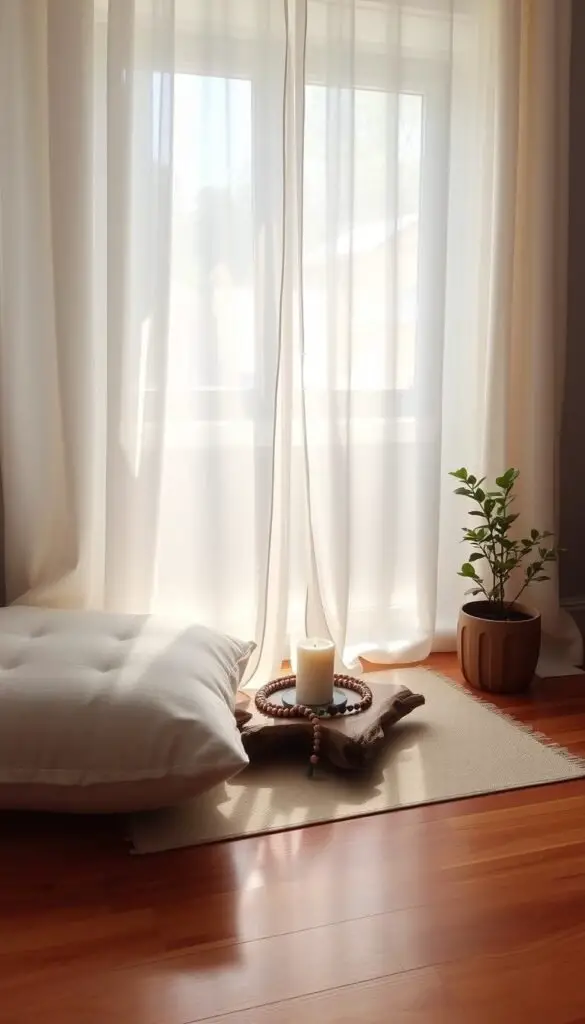
Cushions and Mats
- Zafu cushions support your legs in cross-legged sitting.
- Yoga mats give grip and cushion for sitting on the floor.
- Blankets keep you warm during long meditations.
Opt for organic cotton or wool for a cozy feel in your mindfulness area.
Crystals and Their Significance
“Crystals are tools of intention, not rules.”
Some favorites include:
- Amethyst for calmness
- Clear quartz for clarity
- Rose quartz for self-love
Choose based on what feels right to you. Don’t follow the latest trends!
Incorporating Sound
Sound tools like singing bowls or chimes signal the start or end of meditation. Apps like Insight Timer or Calm offer guided sessions. White noise machines or Himalayan salt lamps with sound features block out distractions.
Setting the Mood for Meditation
Creating a tranquility nook or reflection area is more than just looks. It’s a journey for your senses. By engaging your senses, you turn your space into a peaceful haven. Scents and sounds guide you into mindfulness smoothly.
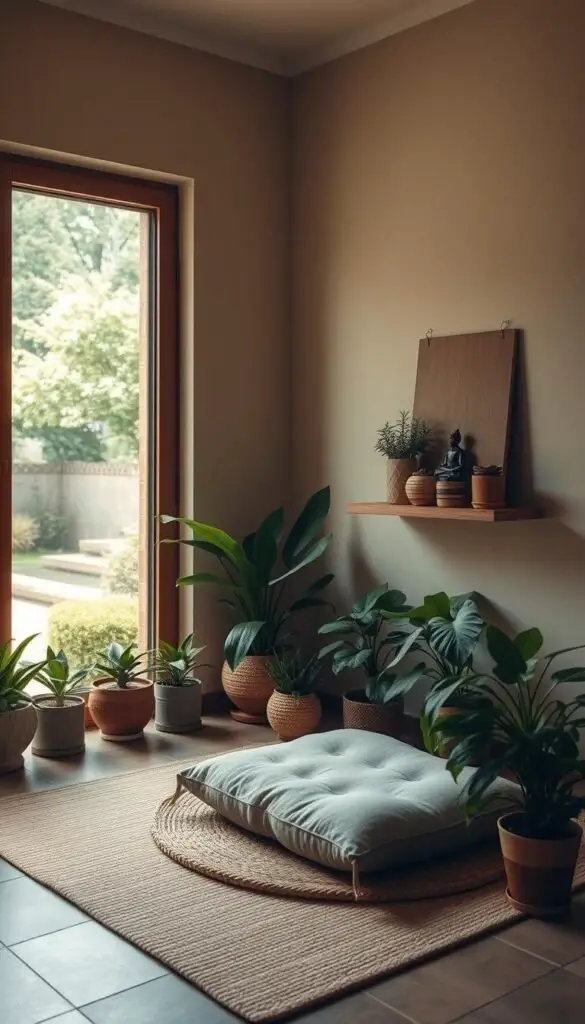
Choosing the Right Scents
Aromatherapy is backed by science. It uses scents to relax you. Here are some good ones:
- Lavender essential oils to calm the mind
- Sandalwood for grounding energy
- Frankincense to enhance focus
Use diffusers or candles for scents. But, keep them light. Strong smells can pull you away from focus.
Using Soundscapes or Music
Sounds shape your mind. Try these:
- Nature recordings like rain or waves
- Traditional tools like singing bowls
- Quiet background music or mindful silence
Find what works for you. Some like quiet rooms, others gentle music. Let your senses guide you to calm.
Establishing a Meditation Routine
Start by making your zen space or contemplation corner a daily habit. Even a few minutes each day can help you become more mindful. Begin with 5 to 10 minutes and slowly increase the time.
Your space will become a signal to calm down. It’s like a mental alarm that tells you it’s time to relax.
Carve Out Time Daily
- Choose a fixed time (e.g., sunrise or bedtime) to create habit muscle memory
- Track progress with a calendar or app for visual motivation
- Try morning meditation to set intentions or evening sessions to unwind
Explore Meditation Styles
Try different styles to see what works best for you:
- Breath focus: Count your breaths to keep your mind focused
- Body scan: Imagine scanning your body from toes to head, letting go of tension
- Loving-kindness: Say phrases like “May I be safe” to spread kindness
- Guided imagery: Picture peaceful places like forests or beaches
“Consistency matters more than perfection. Even 3 minutes in your contemplation corner daily adds up.”
Match your meditation style with your zen space elements. For example, dim lights for body scans or use a cushion for stability. Change your methods every week to keep it interesting. Your meditation corner is more than a spot—it’s a key to your personal growth.
Family-Friendly Meditation Corners
Turn your meditation corner into a relaxation spot for everyone. A family meditation space is more than a personal retreat. It’s a serenity nook where everyone can grow together. Here’s how to make a space that welcomes all ages:
Adapting Spaces for Kids
- Colorful comfort: Use bright cushions and blankets to spark creativity. Brands like Manduka offer kid-sized yoga mats for active mindfulness.
- Short sessions: Start with 3–5 minute practices using breathing games or animal mimicry to keep younger minds engaged.
- Mindful play: Add toys like chime wind chimes or fidget spinners to channel energy into calm focus.
Group Meditation Tips
- Arrange seating in a circle to encourage connection. Use floor pillows or benches for varied heights.
- Set a consistent temperature (68–72°F) to keep everyone comfortable during group sessions.
- Agree on a “mindfulness rule” together, like raising a hand to share thoughts after practice.
Making meditation a family ritual turns your space into a hub of shared calm. Even a 10-minute daily practice can strengthen bonds and teach kids lifelong mindfulness habits.
Maintaining Your Meditation Corner
Keeping your quiet zone in top shape is key to its effectiveness. Regular care ensures it remains a peaceful haven. Think of these tasks as part of your mindfulness practice. They turn routine chores into moments of mindfulness.
Regular Cleaning and Organization
- Wipe surfaces weekly with microfiber cloths to avoid dust buildup.
- Launder cushion covers monthly using gentle detergents to keep fabrics soft.
- Store crystals in a dry place to prevent clouding, and polish them quarterly.
A clean tranquility nook helps clear your mind. Use cleaning time to mindfully rearrange your decor. Try rotating plants or changing seasonal scents.
Refreshing Your Space
Give your space a refresh every 3–6 months with these steps:
- Swap out artwork or quotes to inspire new perspectives.
- Add fresh elements like a small potted succulent or new essential oil blends.
- Rearrange furniture layout to shift energy flow.
Small changes keep your practice feeling new. View updates as a chance to reconnect with your goals.
A well-maintained space is a lasting anchor for your meditation journey. Every touch, from dusting to rearranging, makes this space sacred.
Online Resources and Apps for Meditation
Make your meditation corner or reflection area better with digital tools. Apps and videos can help you focus on mindfulness. They are great for both new and experienced meditators.
“Technology shouldn’t distract—it should inspire your journey toward inner peace.”
Guided Meditation Videos
YouTube and Insight Timer have free and paid guided sessions. Look for creators like Marci Shimoff or Joe Dispenza for structured sessions. Many channels have playlists for stress relief, sleep, or focus.
- YouTube: Search for “10-minute mindfulness” or “loving-kindness meditation” for quick videos.
- Insight Timer: Access thousands of free guided sessions with timers and community features.
- Waking Up (Sam Harris): Science-based meditations for skeptics and newcomers alike.
Recommended Apps for Daily Practice
Apps like Headspace and Calm offer guided programs. Try these options based on your goals:
- Headspace: Beginner-friendly sessions with animated guides.
- Calm: Nature sounds and sleep stories to complement your reflection area.
- Insight Timer: Free and paid courses with a large community for support.
Use these tools with your physical space, like using an app during sunrise in your corner. This creates a complete routine. Explore, experiment, and find what works best for you.
Celebrating Your Meditation Journey
Your meditation corner is more than a room—it’s a gateway to inner peace. To fully embrace its benefits, consider documenting your progress and connecting with others. These steps turn your peaceful space into a lifelong practice.
Keeping a Meditation Journal
A journal helps track how your mindfulness area evolves with you. Note dates, emotions, and insights gained during sessions. Simple prompts like “What felt different today?” or “How did this practice affect my day?” reveal growth over weeks.
Writing down challenges or breakthroughs makes the journey tangible.
Sharing Your Space with a Community
Inviting others to your mindful corner deepens its purpose. Host small group sessions or share tips on platforms like Insight Timer. Online communities like Calm’s forums offer support and ideas.
Teaching others reinforces your own habits, creating shared moments of calm.
Remember, a meditation space isn’t static. Adjust decor, try new techniques, or revisit old ones. Let it grow as you do. The true reward comes from consistency and connection—both inward and with others.

